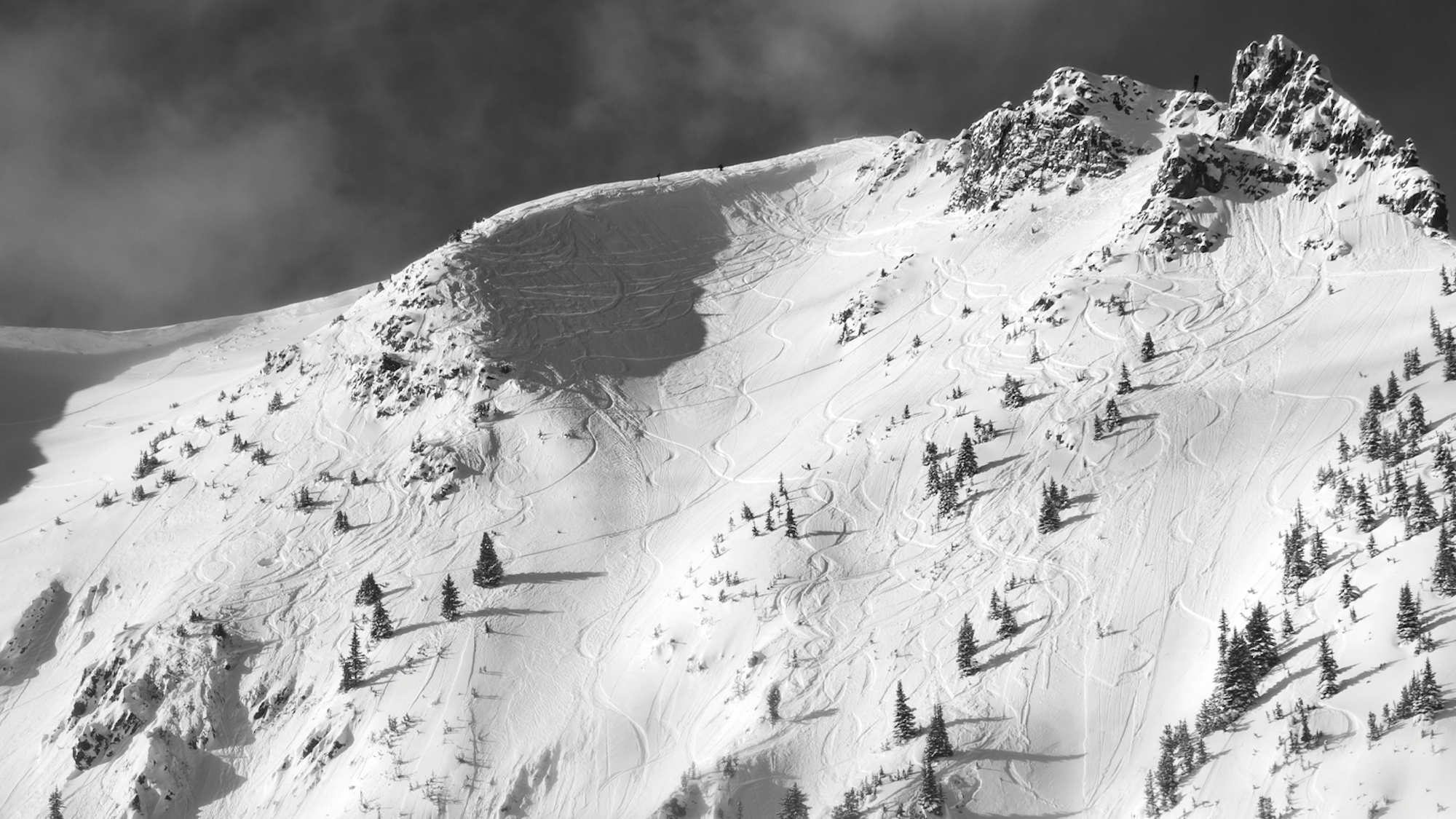WORDS — Matt Coté
For those nerdy enough to pay attention, there are plenty of differences in the American and Canadian lexicons—especially when it comes to ski terminology. While the list goes on-and-on, we’re here to talk about one thing: steep, tight, rock-lined runs in the high-alpine. But are they couloirs or chutes? Gullies? Canada is so replete with couloirs that the bar to qualify as one is high. Canucks have a tendency to call anything less than 1,000 vertical feet a “chute,” and while these lines are equally badass to ski, they’re just not long enough to garner the couloir moniker. In that light, there’s one mountain in British Columbia that is made almost entirely of chutes, and is the epicenter of getting tubed in North America. This is, of course, Kicking Horse Mountain Resort, in Golden, BC, which boasts strings of must-ski lines across its ridges, equivalent to a massive set rolling into Pipeline—gnarly rides stacked up side-by-side. Now that the border is gleefully open to Yankees again, here’s your guide to wrangling some of the most marquee chutes at Kicking Horse this winter.
BEGINNERS START HERE…
Dumpster Chutes
First-timer? We all were at some point. Let me paint the scene for you: Stepping out of the Golden Eagle Express Gondola will be a trippy experience. It’ll shoot you 4,000 vertical feet up in one dizzying ascent, plunking you atop CPR Peak and its adjoining ridge, which form the central spine of Kicking Horse. But don’t go wandering out onto the ridge just yet. The first thing you’ll want to do is head just 100 yards from where you’re standing and slide directly forward, dropping north into Dumpster Chutes. These runs aren’t named on the trail map, but are located directly skier’s left of Trail 64, the Golden Spike. Slide along under the cornice and hop the first few turns with a prominent wall of rocks keeping you humble to your right. The slope mellows quickly and spits out into a wide-open bowl, as an easy way to get your feet wet and prep you for what comes next. There are multiple entrances—move one more skier’s left for a tighter drop-in that forces smaller turns, but flows out into the same glorious open pow field below.
High Horse
Trail 75 on the map, this broad line begins at the top of the north-facing backside of Redemption Ridge and spills into Feuz Bowl. You’ll arrive via the aptly named Stairway to Heaven quad, and shuffle down-ridge only a couple hundred yards, being sure to stay above the cat-track. The first obvious open saddle is the entrance to High Horse, your newest objective. Slightly harder to approach than the Dumpsters but with an easier drop-in, you’ll have a caked, snowy wall to your right and, on your left, the ridgeline will bend as the bowl curves up toward the White Wall. Flanked by two soft boundaries, the line reads like a wide-open, natural halfpipe with tons of room, plus some interesting undulations and bonus pitches once you get lower down. High Horse is one of the longer runs on the mountain, and while it can be difficult to ski in low light, it’ll feels like the Promised Land on a bluebird powder day.
ONCE YOU’RE WARMED UP…
Tunnel Vision
Ready to get your Scot Schmidt on, eh? Head back to the top of the Golden Eagle Express gondola, turn 90 degrees to your right and look for the traverse out to CPR Ridge. Slide over and follow the ridgeline. The first little bit is covered in woops that might make it a challenge to stop right at Tunnel Vision (Trail 63), but it’s your first drop-in past CPR Peak—and usually crowded with gob-smacked onlookers trying to figure out the entrance. But here’s what you need to know to slide right past ’em like a local: There’s a slot carved out of the cornice and that’s where you’ll drop. The first few turns are only a ski-length wide, but the chute opens up shortly thereafter and you’ll be able to link turns more fluidly. Another couple hundred vertical feet downslope and a giant catcher’s mitt of an open fan welcomes you with all the room you’ll need to shut down your speed. It’s a good place to practice letting your skis “run,” and locals often balk at turning in Tunnel Vision at all: many of them straightline the entrance.
Stampede
After you’ve greased your pick on CPR Ridge, jump back onto the Stairway to Heaven lift for another delivery to the top of Redemption Ridge. From there, follow the cat-track below the lift to its end and then stay high to catch the traverse atop the ridge. It’ll take you past a couple of sub-peaks and directly to Stampede, which is in an area known as the Steps. Stampede (Trail 87) is the second Step; it has a sheer wall of rock to the right, and a ramp on the left that you can ride up and down like a spine. The descent offers two options: stick to the choke or schmear the wall. Either way, it all funnels to the same exit point, about 400 vertical feet below, and spits you through it like a high speed hole-in-one. If there’s fresh snow, you’ll need to be aware your slough, or it’ll feel like you’re riding through a Plinko board. At the run’s end there’s a short, open fan to catch you, but it flattens out quick, so don’t get squashed in the compression.
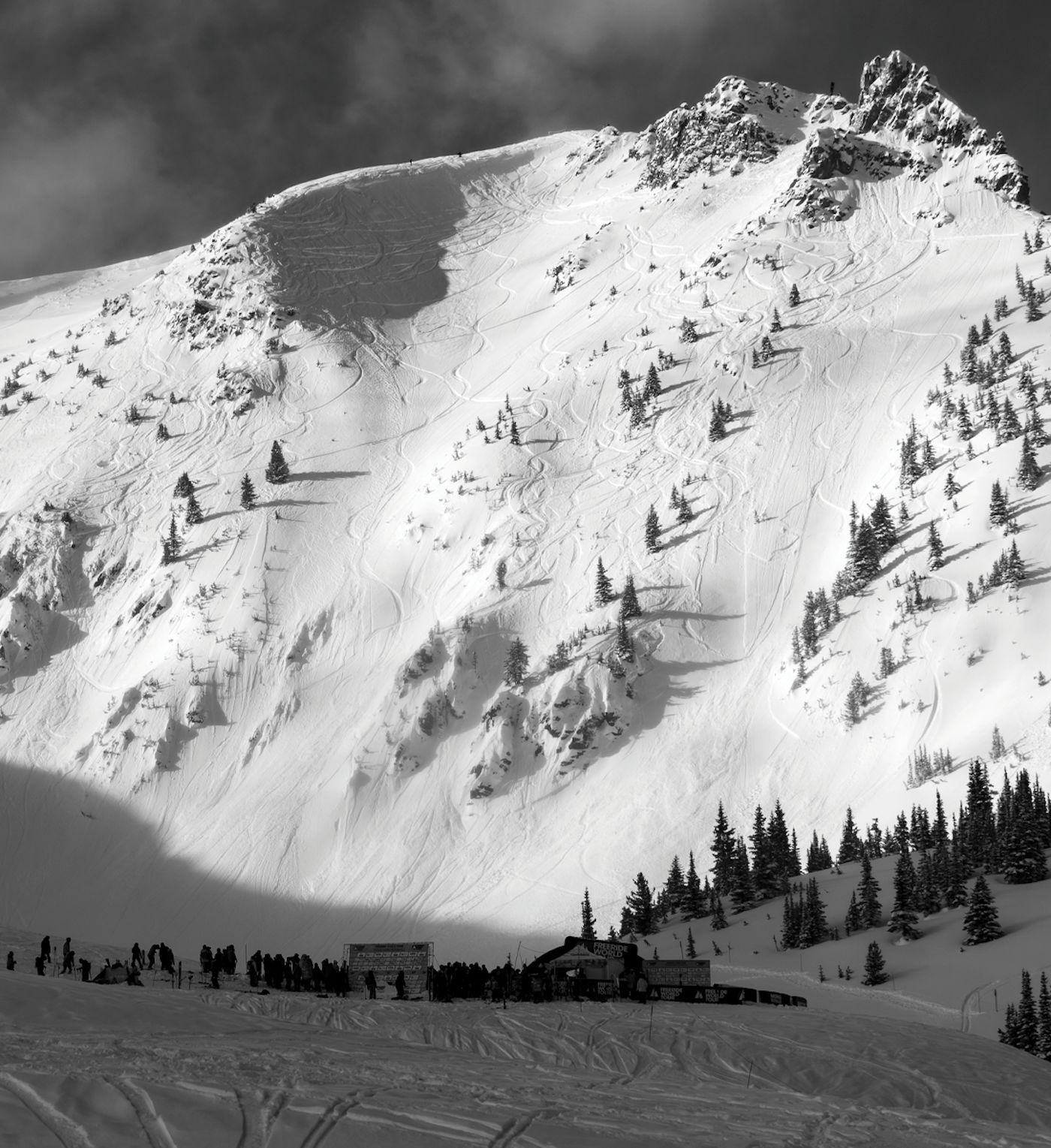
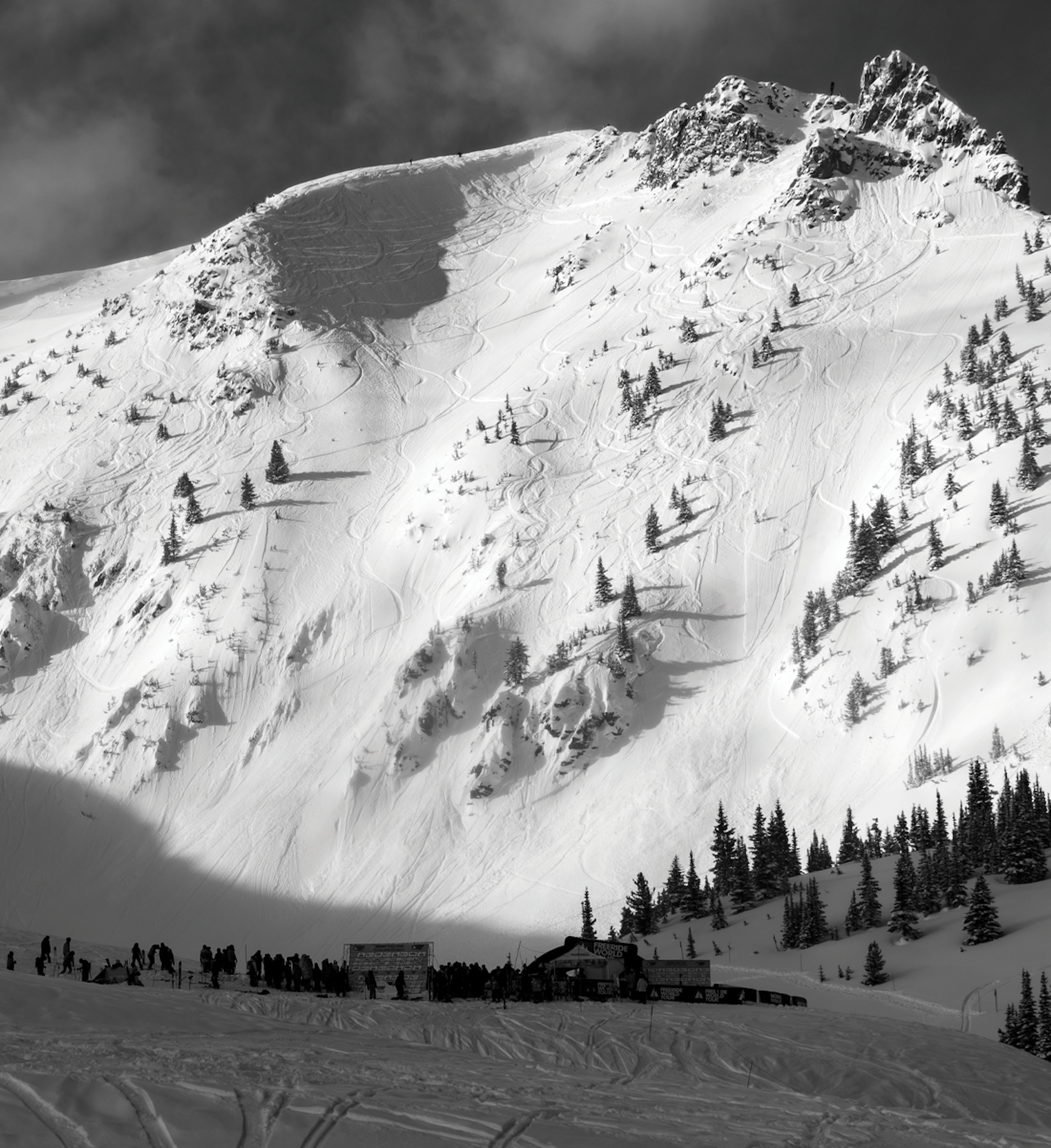
Kicking Horse hosts the only North American stop on the Freeride World Tour and Ozone, pictured above, is the face of choice for the rowdy big-mountain event.
FOR EXPERTS ONLY…
Truth
All steely-eyed, are ya? Well then it’s about time to hit Terminator Ridge—don’t mind the name, though, you’re tough as nails by now. Access this zone by heading south off the Golden Eagle Express and schuss down a quick ridge-top groomer above Bowl Over, before getting to the 20-minute bootpack up Terminator Peak. Get your sweat on, top out and take in the view of three major mountain ranges: The Rockies, Purcells and Selkirks—you’re right in the middle of their wonder. You’re also on top of a peak that’s hosted four-star Freeride World Tour Qualifiers for over half-a-decade. The traverse you want slides across the backside and feels exposed in places, so keep it tight. Wrap around the peak to find the entrance to Truth (Trail 94), with Dare and Consequence a little farther down. Out here, it’ll feel like you’re truly stepping into the backcountry, with a massive, steep, rocky draw funneling you into a choke that has a corner you can’t see around. It all goes and, in the best conditions, you’ll experience damn-near 1,000-vertical-feet of technical, walled-in skiing that, once again, has football fields worth of open fan to catch you at the bottom.
Ozone
Ozone teased and taunted the area’s top riders for nearly two decades before it was finally opened to the public in 2019. It’s now the venue of the only five-star Freeride World Tour stop in North America, which plans to return this winter, barring any Covid nonsense. Accessing Ozone means committing to a 25-minute hike from the top of the Stairway to Heaven chair, and when you get to the peak—the highest point at Kicking Horse—there’s no other way to describe it than… massive. This face provides that pucker factor you’ve been seeking. While there’s no cornice to contend with, it offers two immense line choices. Both of ’em roll over and tighten quickly, keeping you committed to the lines as they steepen and point evermore downward, with spiky rocks bordering you on either side. The rollovers are, of course, blind and, if you have the fundamentals (and the guts) for it, these lines are big enough to crank Super G turns down like you’re starring in the next MSP film. Or you can take your time, and savor the grandeur of one the boldest in-bounds, big-mountain experiences in North America. Ozone is the real deal and it’s up to you how to ski it.

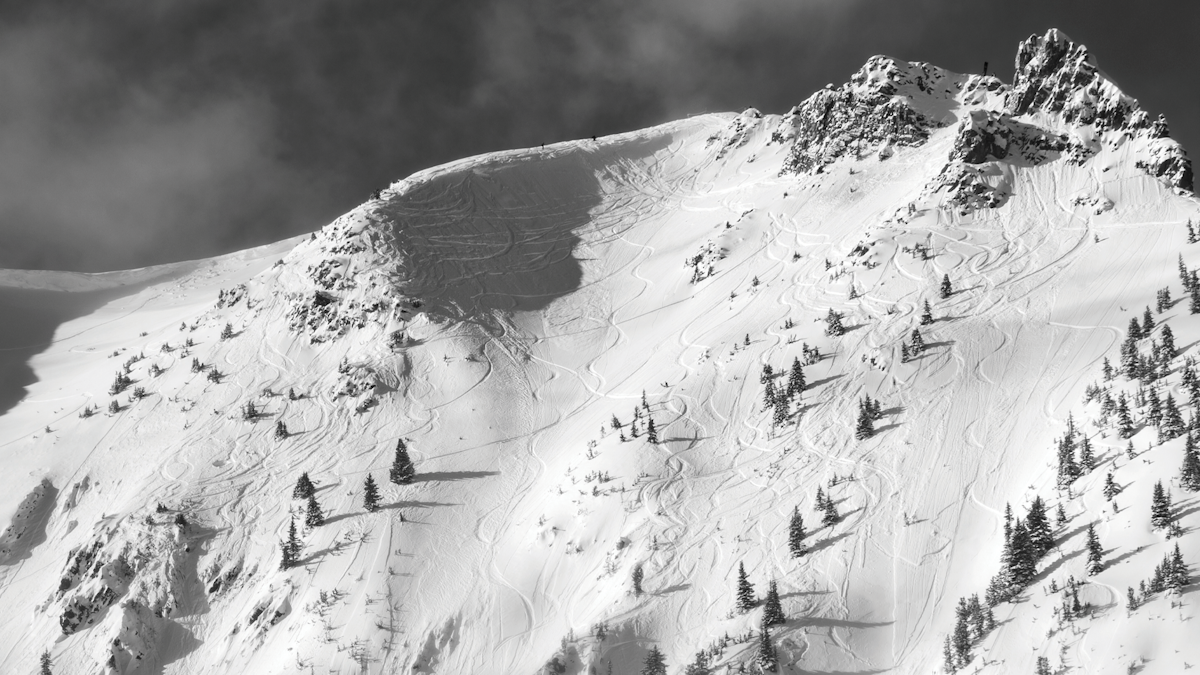



![[GIVEAWAY] Win a Head-to-Toe Ski Setup from IFSA](https://www.datocms-assets.com/163516/1765920344-ifsa.jpg?w=200&h=200&fit=crop)
![[GIVEAWAY] Win a Legendary Ski Trip with Icelantic's Road to the Rocks](https://www.datocms-assets.com/163516/1765233064-r2r26_freeskier_leaderboard1.jpg?auto=format&w=400&h=300&fit=crop&crop=faces,entropy)
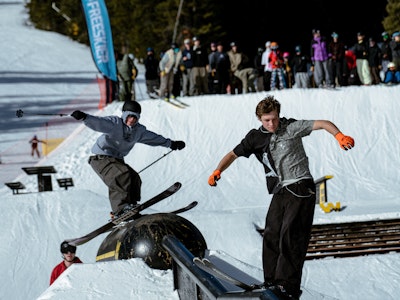




![[GIVEAWAY] Win a Head-to-Toe Ski Setup from IFSA](https://www.datocms-assets.com/163516/1765920344-ifsa.jpg?auto=format&w=400&h=300&fit=crop&crop=faces,entropy)

